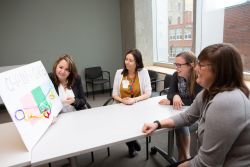High-touch learning with a high-tech twist

‘Transitions in Care’ collaborative learning project marries art and technology for an engaging student placement.
By Emily Dawson
In our first two network-wide collaborative learning placements, 25 students explored transitions in care, and discovered how collaborative practice better supports patients along the continuum of health care services.
Helping patients understand transitions from acute to rehab to community settings is a person-centered approach that keeps people informed, engaged, and confident throughout their health care journey – and how to have these conversations is a fundamental skill for students to learn and practice.
Every year, thousands of students train, learn and grow at our three network sites, and many participate in Interprofessional Education (IPE). This methodology helps students from diverse disciplines learn with, from and about each other. These tighter connections lead to higher quality care.
The genesis for the network’s inaugural collaborative learning placement – marking a milestone in our education portfolio – was a team effort between education colleagues Lindsay Beavers from St. Michael’s Hospital; Melissa Goddard from Providence Healthcare; and Kaitlyn Vingoe and Tina Stewart at St. Joseph’s Health Centre.
“Collaborative learning takes IPE to the next level. It’s even more inclusive, and brings in patients and families and our administrative and support colleagues, too,” said Lindsay. “The transitions in care theme offered a learning experience for a number of different disciplines across a variety of our network’s clinical settings: acute care at St. Michael’s; community care at St. Joe’s; and rehab at Providence.”
The team used an arts-based program, which research shows is an effective way for students to learn. As part of their placement, students were asked to design an art installation to represent and reflect their key learnings.
“It tuned into the parts of our brains, personalities, and skills that we don’t always use in day-to-day health care,” said Angie Bradley, a Social Work student who participated in the learning placement.“Through art, we were able to creatively translate what we do into themes, and open up alternative avenues of communication about our roles and skills. It also sparked conversations about how we can better communicate with patients using other forms of expression, rather than relying on medical jargon.”
Video conferencing technology enabled students to virtually collaborate across sites (the first placement involved Providence and St. Michael’s students; the second had St. Michael’s and St. Joseph’s students) – allowing facilitators to share synchronous content and activities while each group independently created artwork that was temporarily displayed at the three sites for public viewing.
A survey at the end of the placement showed that 40 per cent of learners noted they were most engaged during the creation of the art project. They also said that their learning was enhanced by the technology, which increased both the number of student participants and the variety of disciplines. In total, the students represented 12 professions; this diversity deepened their insight on the theme.
“I think in many cases, and this is also true outside of health care, different disciplines operate in silos. Opening up communication and approaching our jobs in partnership with other practitioners builds more person-centered care,” said Angie. “I can also now look for opportunities to include technology and art into other aspects of care. For example, connecting virtually to a team at another facility during a patient’s transition would provide a more personal context that case notes and charts don’t always capture.”
